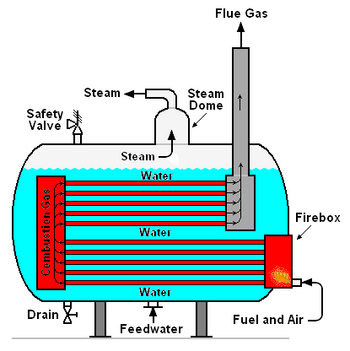User:Milton Beychok/Sandbox: Difference between revisions
imported>Milton Beychok No edit summary |
imported>Milton Beychok |
||
| Line 8: | Line 8: | ||
==Evolution of steam generator designs== | ==Evolution of steam generator designs== | ||
{{Image|Fire-tube Boiler.png|right|350px|Add image caption here.}} | |||
;Fire-tube boilers: | |||
In the late 18th century, various design configurations of fire-tube boilers began to be widely used for steam generation in industrial plants, railway [[locomotive]]s and [[steamboat]]s. Fire-tube boilers are so named because the fuel combustion product gases flow through tubes surrounded by water contained in an outer cylindrical drum (see Figure 1). Today, steam-driven locomotives and river boats have virtually disappeared and fire-tube boilers are not used for steam generation in modern utility power plants. | In the late 18th century, various design configurations of fire-tube boilers began to be widely used for steam generation in industrial plants, railway [[locomotive]]s and [[steamboat]]s. Fire-tube boilers are so named because the fuel combustion product gases flow through tubes surrounded by water contained in an outer cylindrical drum (see Figure 1). Today, steam-driven locomotives and river boats have virtually disappeared and fire-tube boilers are not used for steam generation in modern utility power plants. | ||
| Line 13: | Line 16: | ||
However, they are still used in some industrial plants to generate [[Steam|saturated steam]] at [[pressure]]s of up to about 18 [[bar]] and at rates ranging up to about 25,000 kg/hour. In that range, fire-tube boilers offer low capital cost, operational reliability, rapid response to load changes and no need for highly skilled labor. | However, they are still used in some industrial plants to generate [[Steam|saturated steam]] at [[pressure]]s of up to about 18 [[bar]] and at rates ranging up to about 25,000 kg/hour. In that range, fire-tube boilers offer low capital cost, operational reliability, rapid response to load changes and no need for highly skilled labor. | ||
The major shortcoming of fire-tube boilers is that the water and steam are contained within the outer cylindrical | The major shortcoming of fire-tube boilers is that the water and steam are contained within the outer cylindrical shell and that shell is subject to size and pressure limitations. The [[tensile stress]] (or [[hoop stress]]) on the cylindrical shell walls is a function of the shell [[diameter]] and the internal steam pressure:<ref>[http://courses.washington.edu/me354a/chap12.pdf Pressure vessels:Combined stress] From the website of the Mechanical Engineering Department at the [[University of Washington]]</ref> | ||
:<math>\sigma = \frac{p\, d}{2\, t}</math> | |||
{|border="0" cellpadding="2" | |||
|- | |||
|align=right|where: <math>\sigma</math> | |||
|align=left|= tensile stress (or hoop stress), [[Pascal|Pa]] | |||
|- | |||
|align=right|<math>p</math> | |||
|align=left|= Internal [[Pressure|gauge pressure]], Pa | |||
|- | |||
|align=right| <math>d</math> | |||
|align=left|= internal diameter of drum, m | |||
|- | |||
|align=right|<math>t</math> | |||
|align=left|= thickness of drum wall, m | |||
|} | |||
The ever-growing need for increased quantities of steam at higher and higher pressures could not be provided by fire-tube boilers because, as can be seen in the above equation, both higher pressures and larger diameter shells led to prohibitively thicker and more expensive shells. | |||
;Water-tube boilers: | |||
==References== | |||
{{reflist}} | |||
Revision as of 22:52, 17 November 2009
A steam generator is a device that uses a heat source to boil liquid water and convert it into its vapor phase, referred to as steam. The heat may be derived from the combustion of a fuel such as coal, petroleum fuel oil, natural gas, municipal waste or biomass, a nuclear fission reactor and other sources.
There are a great many different types of steam generators ranging in size from small medical and domestic humidifiers to large steam generators used in conventional coal-fired power plants that generate about 3,500 kilograms of steam per megawatt-hour of energy production. The adjacent photo depicts an 1150 MW power plant with three steam generators which generate a total of about 4,025,000 kg/hour of steam.
Many small commercial and industrial steam generators are referred to as "boilers". In common usage, domestic water heaters are also referred to as "boilers". However, domestic water heaters do not boil water nor do they generate any steam.
Evolution of steam generator designs
- Fire-tube boilers
In the late 18th century, various design configurations of fire-tube boilers began to be widely used for steam generation in industrial plants, railway locomotives and steamboats. Fire-tube boilers are so named because the fuel combustion product gases flow through tubes surrounded by water contained in an outer cylindrical drum (see Figure 1). Today, steam-driven locomotives and river boats have virtually disappeared and fire-tube boilers are not used for steam generation in modern utility power plants.
However, they are still used in some industrial plants to generate saturated steam at pressures of up to about 18 bar and at rates ranging up to about 25,000 kg/hour. In that range, fire-tube boilers offer low capital cost, operational reliability, rapid response to load changes and no need for highly skilled labor.
The major shortcoming of fire-tube boilers is that the water and steam are contained within the outer cylindrical shell and that shell is subject to size and pressure limitations. The tensile stress (or hoop stress) on the cylindrical shell walls is a function of the shell diameter and the internal steam pressure:[1]
| where: | = tensile stress (or hoop stress), Pa |
| = Internal gauge pressure, Pa | |
| = internal diameter of drum, m | |
| = thickness of drum wall, m |
The ever-growing need for increased quantities of steam at higher and higher pressures could not be provided by fire-tube boilers because, as can be seen in the above equation, both higher pressures and larger diameter shells led to prohibitively thicker and more expensive shells.
- Water-tube boilers
References
- ↑ Pressure vessels:Combined stress From the website of the Mechanical Engineering Department at the University of Washington






